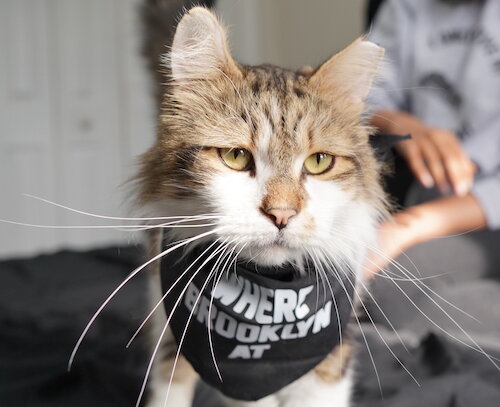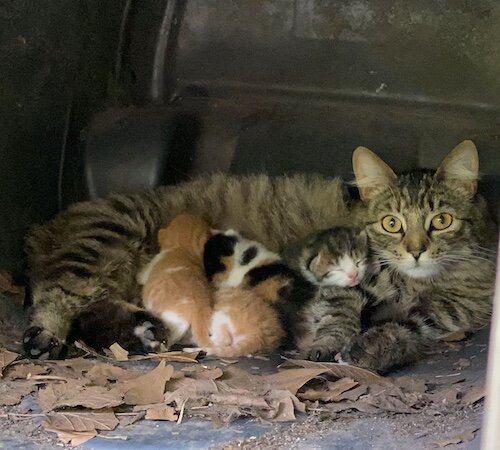This is a repost of our full interview with Shelter Reform Action Committee, shared as part of their October 2020 email newsletter.
by Esther Koslow
In early March 2020, SRAC President Esther Koslow traveled to Flatbush, Brooklyn to meet with Will Zweigart, founder and Executive Director of Flatbush Cats. As Koslow learned, Flatbush Cats was poised to re-set the paradigm for Trap/Neuter/Return (TNR) in NYC.
But intervening events ... in the form of a worldwide pandemic ... delayed publication of that interview.
COVID-19 was an earthquake for animal rescue. ACC restricted its intake numbers and shut down its “Community Cat Project.” ASPCA closed its spay/neuter clinics for rescuers and the public. And throughout the following seven months, the number of free roaming cats increased (multiplied by the onset of Kitten Season).
NYC’s finances have been devastated. In turn ACC faces budget cuts. So it’s up to cat rescue and TNR groups to fill the void as regards cats. But can they?
During the first seven months of the COVID-19 crisis, we checked in periodically with Zweigart. While efforts to reduce the number of NYC’s free roaming cats has taken a gut punch, we are heartened by what Flatbush Cats has been able to do.
We believe that Flatbush Cats can show the way to dig us out of this big hole in animal rescue. The following interview is a compilation of the March interview and subsequent telephone conversations between Esther Koslow (EK) and Will Zweigart (WZ):
EK: Good afternoon, Will. So nice to meet face to face with the fellow who appears in some of the unusual videos featured on Flatbush Cats’ YouTube Channel. Yours is a relatively new group. When did you create it and why?
WZ: We started doing rescue and TNR in the same way that most people do - moved to a different part of Brooklyn and spotted cats on our block. That set me on a journey to understand why cats were suffering on the street, and what we could do about it. I’d never heard about trap neuter return (TNR).
I found getting started to be a series of almost unending obstacles - finding information, knowing what to do, how to get traps, how to get spay/neuter appointments and transport them, what to do about kittens, sick cats, friendly cats...it was an entirely new world, and it seems like you’re on your own, because for the most part you are.
And I found it really odd that being a cat lover all my life, I’d never even heard about any of this. That tells you something about the challenges ahead because we can’t solve a problem that most people aren’t even aware of.
EK: Is Flatbush a hotbed of free roaming cats?
WZ: One rough formula is to assume 1 cat for every 10 people, so I’m guessing a few thousand at least - we have 300,000+ residents in our four target zip codes.
Part of the problem is we don’t know: there’s not a lot of information being collected or shared. I was able to get recent intake data by zip from ACC, but that’s a small part of the equation because many of our neighbors do not know about ACC. Cats are often just discarded or put on the street instead of being surrendered, people think they’ll be killed at a shelter and they incorrectly assume it’s OK for them to be outside.
In areas where we’ve done TNR you will find very few cats. In areas where we haven’t done TNR yet, you can often find several colonies on each block, living on the sidewalk, in backyards and behind apartment buildings.
EK: What percentage of friendly cats do FC members trap?
It’s a growing percentage - rescuers are running into more friendly cats than ever. They also are more visible and out in the open than a feral cat, so more likely to be spotted on a walk or reported by a neighbor. It’s very rare that we do a TNR project without running into at least one friendly cat that needs to be vetted and placed with a foster.
We have also found friendly ear tipped cats who were returned as part of the ACC return to field program, according to their microchip. I understand the concept of RTF (return to field) and we appreciate that this means fewer cats are euthanized, but in some cases this approach passes the burden back to local rescue volunteers.
EK: Allow me to interject. For the record, SRAC opposes ACC’s returning friendly cats to the streets.
WZ: I support and really appreciate what ACC does, and recognize RTF as a pragmatic way to reduce euthanasia in shelters, but this program needs a bit more transparency. Particularly around how cats are tracked and reported. I don’t see any breakouts in their reports about the number of cats that were put back outside. Surely that wouldn’t count as a placement through the New Hope program, so where are they being recorded?
EK: Actually, they are recorded as “transfers” ... to a New Hope group. But that designation is misleading: the group in question never sees any of these cats. Instead, ACC employees and volunteers return the cats to the streets.
WZ: Right now you get an email if an ear tipped cat shows up at ACC from your area. We should also get an email when an ear tipped cat is put back on the street.
It’s hard to criticize a system that is so underfunded as well, of course there will be issues. But they do a ton with what they have.
I’ve noticed many difficult subjects like this are not mentioned publicly. And I understand why – they’re complex and reflect difficult choices. But there’s a cumulative effect over the years, when you only talk about the lighter, more donation-friendly subjects like rescue and adoption. Happy and heroic stories, basically.
That means many cat lovers and potential supporters have no idea what the real problem is and what we need to do to solve it. That puts the burden on smaller groups once again to try and explain these things.
The number of friendly strays in Brooklyn is a major issue, because whenever you trap or rescue a friendly cat, that slows down your TNR efforts tremendously. You need to be really focused on time and resource management, otherwise you’ll start out as a TNR group and end up as a cat rescue six months later. Then burn out a few months after that if you don’t impose guard rails, because the cats will keep coming.
EK: So, FC doesn’t return friendly cats to the streets?
WZ: No, we find them homes. But unlike a city shelter, we’re able to halt intake when we’re maxed out. It’s the same thing as a shelter saying they’re “no kill” because they’re not required to accept animals from the public regardless of current capacity.
Right now we have several dozen cats in our foster care, but there are always other friendly cats that we can’t get to. We will always prioritize TNR projects first, because over the long term, keeping TNR as the main focus will reduce the number of cats needing help.
Our goal is to expand TNR services in Flatbush and eventually more parts of Brooklyn, training volunteers to manage projects on their own block, and prioritizing friendly cats when they are attached to TNR projects (which is plenty).
EK: What services does FC provide to its members?
We remember how challenging it was to get started, so we aim to provide anything you could possibly need as a local TNR volunteer. We broke down the main obstacles into three buckets: training, project support and resources.
For training, we just started teaching a free online certification course with the ASPCA (they call it TNRM - trap neuter return monitor). Anyone that wants to learn can register at www.flatbushcats.org/tnr. Hopefully we can train 1,000+ new volunteers in NYC and beyond over the next few months.
For project support, we offer volunteers within our service area whatever we can - mentoring, traps to borrow, donated food, holding space, transport, spay/neuter appointments.
And as far as resources, we believe cost shouldn’t be a barrier – if you’re doing the work, you shouldn’t also be paying huge vet bills out of your own pocket right? So we offer help placing friendlies, covering unexpected medical costs, or covering spay/neuter at a low cost vet if you can’t get a spot at the ASPCA for TNR.
We want to eliminate all the obstacles to doing TNR in the city, until it’s just a matter of giving your time and energy. We have a very small number of active volunteers in the Flatbush area right now, but that is a much more important metric to us than adoptions.
EK: Who provides spay/neuter services for FC?
This is the biggest challenge right now, by far – and worth noting that it was also the biggest challenge before COVID-19. ASPCA spay/neuter clinics were closed from March to around August, with a soft opening at 25% capacity. They are up to 50% capacity now and will be at that level likely through the end of the year. What that means in reality is TNR volunteers have to fight for every appointment they can get – no one has enough.
We also work with The Toby Project mobile clinic, which is amazing, but has limited capacity. The only remaining options are private vets. Very few will offer low cost services to rescuers, they book up 3-4 weeks in advance and charge around $90-120 per cat. Other vets are charging $400 or more for spay/neuter.
We spent over $10,000 this summer on spay/neuter surgeries at private vets when the ASPCA was closed or at reduced capacity. Around half of that was to cover the costs for other TNR rescue volunteers in Brooklyn who needed help to keep going. It’s really hard to TNR an entire colony through these channels.
I want to note, we really appreciate everything the ASPCA does, and none of this work would be possible without their high volume clinic. We just happen to be woefully under-resourced at a city level, and have been for a long time. We need several more high volume clinics if we’re serious about addressing this - which would actually save millions of dollars in the long run too.
EK: What’s your 5-year plan for Flatbush Cats? And what resources will you need?
Our mission is to reduce the street cat population in Brooklyn down to zero. To do that, we have to do two things:
First, make it easier for volunteers to get involved in TNR. In Q1 2021 we’re launching a new Community Cat Program in our service area. We’ll be hiring our first full-time employee (and Brooklyn’s first Community Cat Program Manager) to provide community outreach, training and project/resource support for volunteers.
To see results, we need to be at the grassroots level - one volunteer, one colony, one backyard at a time. This will take 1-2 years to unfold, but over time we should be able to track reduced ACC intake from those zips and keep the numbers down.
Second, we have to stop the cats from appearing on the street in the first place. We need to make it easier for everyone, especially low-income residents, to get their cats spayed and neutered.
That means we need to add new spay/neuter capacity in Brooklyn. A city with a population of 250,000 should have one high volume spay/neuter clinic. Brooklyn has ten times that number of residents while having no clinics, so this is a pretty obvious next step.
We can’t scale up TNR programs or community outreach without scaling up spay/neuter capacity first. It should be affordable and accessible for everyone, period. So we’re looking into that through partnerships. Stationary spay/neuter clinics are not my area of expertise – I’d much rather someone else open a few throughout Brooklyn! But we’ll go there if needed, no question, and we’ve already been exploring options.
EK: Does FC provide services to TNR rescuers outside of Flatbush?
WZ: We have been supporting TNR volunteers in Brooklyn in a few ways this year, mainly around covering spay/neuter surgeries and providing donated food.
We created a dedicated support group on Facebook for TNR certified Brooklyn volunteers that’s up to 340 members, which is awesome. We’re also building a knowledge base and FAQ so newly-certified folks can get help navigating the maze of spay/neuter appointments, low cost vets, etc.
We host a free winter shelter building workshop every October, and provided 3,000 pounds of cat food to Brooklyn TNR volunteers and low income residents over the summer, thanks to a partnership with the ASPCA’s Bronx food bank. We’re hoping to create a larger community food bank for Brooklyn TNR volunteers next year. People need to feel supported when they are just starting out or running into challenges.
EK: Can the FC model be expanded to other neighborhoods?
WZ: Yes, it should be open source. Our model is inspired by other leading groups, including C5 in Las Vegas. We spoke with seven leading nonprofits around the country with similar programs to understand the best approaches that would work for our area.
Once our community cat program is up and running, we’ll be working with others in Brooklyn to scale parts of it next year. Some aspects would be more efficiently managed at the borough level, like tracking incoming TNR projects against available spay/neuter capacity, so we can prioritize high impact colonies and target areas.
I’m a strategist and problem solver by day, and part of my job is to find the right questions. Why continue to rescue cats for another decade without tackling the root cause? Let’s fix this. We’ve seen enough suffering already. That’s why we’re not a rescue-centered organization; it’s clear we can’t adopt our way out of this.
We put a big emphasis on storytelling to inspire other cat lovers to get involved. I believe every cat has a story, and every story has a lesson. I’m passionate about documenting this work for educational purposes, particularly showing the beautiful moments we experience along the way.
That approach has helped us build one of the largest audiences in NYC from an animal welfare standpoint, with over 500,000 followers across our social channels. Our YouTube videos are packaged as beautiful stories, but they all carry such important educational messages. They’ve been viewed over 30 million times just in the last year or so.
EK: Thirty million views!?
WZ: Yes, and we’ll continue to use this platform to inspire and build awareness around TNR and rescue, even the difficult topics.
As a bonus, if you’re telling the story correctly, and showing your work, you can spend a lot less time fundraising to cover the bills or looking for adopters.
But it’s not necessary that others replicate a certain skill set - we need a network of strong leaders with strengths that complement each other. People who are motivated by the goal and willing to work together, even outside their comfort zone.
I lack the patience for government affairs, for example, so would love to partner with those who are passionate about working with city leaders to effect change over the long term with a dedicated Animal Welfare Department and municipal funding. We appreciate what SRAC does so much!
EK: Thanks for the thumbs up. What major challenges has COVID-19 presented to FC?
Here are some of the challenges cat rescue and TNR have faced since then:
After closing all their ASPCA spay/neuter clinics last March, ASPCA is now only at 50% capacity. But even before COVID, securing a spot with the ASPCA was a major challenge.
Thousands more cats will be born on the street this summeryear.
More cats will be dumped or abandoned due to financial stress.
Several TNR volunteers lost jobs, were quarantined, or left the city.
Transportation is much more risky/challenging (most of us don’t have cars).
Most private vets are booked several weeks in advance.
Some private vets stopped offering spay/neuter for rescues.
Of course, there has been a silver lining, too: interest in adoption and fostering has been a bit higher while people are stuck home.
We’ll get through this, and I’m so impressed by the tenacity that TNR and rescue volunteers across the city have shown this year.
But there’s no point in trying to get back to the way things were. That won’t be enough. Let’s take this opportunity to note where systemic change is needed, and try new approaches.
EK: Amen to that. Thanks so much, Will, for all that you do. In this age of COVID, I think it’s fair to say that Flatbush Cats has been a shot in the arm for TNR volunteers and groups.
You can learn more about The Shelter Reform Action Committee on their site.





